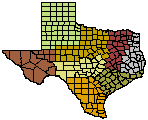- Trans Pecos
- High Plains/Panhandle
- Cross Timbers
- Hill Country
- Post Oak Savannah
- Pineywoods
- Oak Prairie
- South Texas Plains

Wildlife Division District Map
Hill Country Wildlife Management
Historical Perspective
The appearance of Hill Country rangelands is very different today compared to 150 years ago. The grasslands, which were dotted with an occasional live oak motte, are no more. Midgrass and tallgrass communities have been replaced with shortgrass communities (where grasses persist). Grasslands were replaced by parklands and woodlands. Ashe juniper has spread from the steep draws and canyons and exploited the uplands. Replacement of many deciduous trees (e.g., Spanish oak, madrone, Lacey oak) is nonexistent, and the species will die (locally) with the parent trees.
Climatic conditions in the Hill Country, and their highly variable nature, undoubtedly contribute to alterations of the landscape. While several factors contribute to long-term and large-scale landscape changes, recent changes in the appearance of the Hill Country are primarily a result of two factors: (1) overgrazing/over-browsing by domestic livestock and wild herbivores, and (2) fire suppression. Since the "Golden Period," many rangelands have been overstocked with sheep, goats, and cattle. More recently, white-tailed deer and exotic ungulates have increased to numbers far surpassing the rangeland's carrying capacity. Overstocking rangelands with livestock is largely a result of our naivete of the widely fluctuating patterns of climatic conditions in the Hill Country. Terry Jordan (1966) best describes this logic:
"If overall averages are considered, the western end of the German belt lies just on the humid subtropical side of the border with the semi-arid climates. However, as is often the case in climatic transition zones, the averages are misleading, for in any given year the Texas Hill Country and the plains which border it may fall well within the area of semi-arid climates, and feel the hot, withering breath of the desert to the West. Average temperatures range from about 50° F. in January to over 80° F. in July and August, and the growing season is around 250 days. Perhaps the most outstanding characteristic of the climate is the unreliability of precipitation. The figure for the average annual rainfall at Fredericksburg in Gillespie County, 27.5 inches, means very little when only 11 inches fall in one year and 41 inches the very next, as happened in 1956 and 1957. In the nineteenth century, two of the four census years used, 1859 and 1879, were marred by severe drought. The wet years served only to convince the inhabitants that the dry ones were exceptional strokes of bad fortune, while in fact they were part of the normal course of climatic events, to be expected in such a transition zone. As was often the case along the border of the semiarid lands in North America, the settlers did not realize or would not admit that they were on the rim of a desert."
European settlement thrived during the "Golden Period" when grasslands were lush and seemed capable of supporting an unlimited number of livestock. As Jordan wrote, "the settlers did not realize or would not admit that they were on the rim of a desert." This attitude resulted in abused rangelands lacking adequate groundcover and available browse to support healthy livestock and wildlife populations.
Some may best know the Hill Country as the "Deer Factory of Texas", as it supports the largest white-tailed deer population in the state. Although deer hunting is a major industry in this region, the area where Mason, Gillespie and Llano counties converge supports the highest deer density in the nation, with one deer for every 2 to 3 acres. Several species of exotic ungulates also range freely throughout much of the central and western plateau. Deer densities of this magnitude are denuding rangelands.
A single-species approach to wildlife management also has led to large-scale landscape changes in the Hill Country. The expansion of Ashe juniper has had a tremendous impact on the ecosystem, causing a decrease in plant species diversity and an increase in soil erosion. Cedar brakes lose a significant amount of precipitation through transpiration and overland flow, leaving much less water for aquifer recharge. While overgrazing and fire suppression have contributed to cedar invasion of upland sites, subsequent protection of Ashe juniper (for endangered wildlife) has compounded the problem. As the groundwater resources are being depleted, associated fauna is threatened.
The key to managing natural resources is to use a holistic approach, where all of "Leopold's Tools" (cow, plow, ax, fire, and gun) are applied to develop and maintain healthy ecosystems. Single species deserve less attention, while the system in which they thrive requires more. Knowing how that system functions, and applying the techniques with which that system developed (e.g., moderate cattle grazing, prescribed burning, hunting) is imperative for its continued existence.
References:
Jordan, T. G. 1966. German seed in Texas soil: immigrant farmers in nineteenth-century Texas. University of Texas Press, Austin, Texas, USA.